
STATUS
CLOSED
$3106 | 57 backers | 155% of $2000 (goal/1 episode)
Support items & packages
-
 3 DVD Set – episodes 1-3 – Blacksmithing 101 series85 $
3 DVD Set – episodes 1-3 – Blacksmithing 101 series85 $ -
 The Video Downloads Package – Blacksmithing 101 Series67 $
The Video Downloads Package – Blacksmithing 101 Series67 $ -
 Credit in the videos – Blacksmithing 101 series168 $
Credit in the videos – Blacksmithing 101 series168 $ -
 The Special Contributor Package – Blacksmithing 101 series276 $
The Special Contributor Package – Blacksmithing 101 series276 $ -
 How to forge blacksmith tongs – Blacksmithing 101 Series – DVD25 $
How to forge blacksmith tongs – Blacksmithing 101 Series – DVD25 $ -
 Making Simple Forged Objects – DVD – Blacksmithing 101 Series25 $
Making Simple Forged Objects – DVD – Blacksmithing 101 Series25 $ -
 The Basics of Forging – Blacksmithing 101 Series – DVD35 $
The Basics of Forging – Blacksmithing 101 Series – DVD35 $ -
 How to forge blacksmith tongs – Blacksmithing 101 series – Video Download19 $
How to forge blacksmith tongs – Blacksmithing 101 series – Video Download19 $ -
 Making Simple Forged Objects – Blacksmithing 101 series – Video Download19 $
Making Simple Forged Objects – Blacksmithing 101 series – Video Download19 $ -
 The basics of forging – Blacksmithing 101 series – Video Download29 $
The basics of forging – Blacksmithing 101 series – Video Download29 $
Preordering our videos helps us make English versions for a wider audience and continue to work on the next episodes. As soon as we’re ready with the English version, your order will be updated and we will give you access to the versions that has English voice over. At the moment you can only enjoy the Hungarian version and get some ideas how hard our language is. English versions’ estimated delivery late 2020/early 2021. We truly appreciate all your support!
Blacksmithing 101 Crowdfunding Campaign 2020 Contributor list
Video teasers for the first three episodes of the series that are available (only in Hungarian at the moment). More info below
Still got questions? Order your video tutorials below! Help us preserve traditional blacksmithing!
Are you a hobbyist blacksmith? Or a professional? Or both at the same time? Would you like to deepen your forging skills? Getting to know some tricks? Or just check out how the others are doing it. Get access to step by step video tutorials by Hungarian artist blacksmiths, members of the Hungarian Blacksmith Guild! Help us preserve traditional forging for future generations! We need your help to make this happen! We’re better together!
Short Summary
Keeping the blacksmith traditions alive has always been the primary aim of the Hungarian Blacksmith Guild. In Hungary not only has vocational training for the blacksmiths ceased to exist, but this profession has also been removed from the official list of occupations. Some might say that this noble profession, dating back more than 4000 years, is virtually dying. As a result, it is up to those handful enthusiasts who cultivate the blacksmith profession and those with ardor interest for the trade to reverse this judgement. This is why in 2019 we decided to make a series of educational videos.
Why it’s important to us
We want to help those who are not only interested, but are willing to make an effort and learn this beautiful yet difficult profession. In our films we present you the tricks of the trade: what it takes to get from the basics to the master level. We have put together an easy-to-follow, step by step guide that anyone can follow. If you aquire the basic tools, devote enough time, effort and energy to these forging exercises, you will attain the lore of the blacksmith.
Our first film (Basics of forging) in the series encompasses the basic techniques of forging. We start with the basics, namely how to stand beside the anvil, how to hold and handle the hammer properly to achieve an efficient hammering technique. Then we will go through thebasic techniques of a blacksmith, such as stretching, widening, shouldering, upsetting, punching and splitting. With these you will learn how to manipulate and re-shape any workpiece.

The second film (Forging simple objects) in the series showcases the creation of those simple forged objects, which in Hungarian tradition were made by the blacksmith’s apprentice. By making these small tools you can practice the basic techniques while creating useful yet fine objects. At the same time, these exercises will provide you a good example of developing simple operational sequences from the aforementioned basic techniques.

In the third part (How to make a tong) of the series we present you the techniques to make forging tongs: one of the most important tools of a blacksmith, alongside the hammer and the anvil. Blacksmiths make a lot of their tools themselves. Among these, forging tongs are the most significant ones, as you could only buy these from other blacksmiths or purchase them at scrap metal yards. This is why it is very important that those who want to practice blacksmithing learn the characteristics of a good tong and the process of forging tongs at an early stage. With this you will be able to make the right tool for each of your new tasks. In addition, making tongs is an excellent way of practicing your basic forging techniques, providing you with further opportunities to develop simple operational sequences from the already mentioned basic techniques.

The Basics of forging
-
 The Basics of Forging – Blacksmithing 101 Series – DVD35 $
The Basics of Forging – Blacksmithing 101 Series – DVD35 $ -
 The basics of forging – Blacksmithing 101 series – Video Download29 $
The basics of forging – Blacksmithing 101 series – Video Download29 $ -
 Blacksmithvideos – Support T-Shirt24 $ – 26 $
Blacksmithvideos – Support T-Shirt24 $ – 26 $ -
 Hat – Blacksmithvideos Support item25 $
Hat – Blacksmithvideos Support item25 $ -
 Devil’s Blacksmith – Support T-Shirt24 $ – 26 $
Devil’s Blacksmith – Support T-Shirt24 $ – 26 $ -
 Devil’s Blacksmith – Support Hat35 $
Devil’s Blacksmith – Support Hat35 $
Video tutorial chapters
- Drawing down
- Spreading
- Shouldering
- Upsetting
- Punching
- Splitting
- Making simple decorative elements (knob, leaf)
Running time: 83 minutes
Tutors
ZOLTÁN TAKÁTS, Hungarian artist blacksmith was born in Pécs, Hungary in 1949. He graduated as a goldsmith from the Pécs High School of the Arts in 1968. Having worked as an apprentice for a blacksmith, he became an agricultural blacksmith in 1970. In 1972 he built his own studio and workshop in Pilisborosjenő, where he continues to work to this day.

In 1974 he received the title of Young Master of Folk Art and then the title of Master of Folk Art in 1980. Since 1986 he has been a member of the Hungarian Artists’ Association. He is a founding member, and from 1992 to 2019 the guild master of the Hungarian Blacksmith Guild.

Since 2006 he has been a member of the Folk Art Evaluation Committee. As part of a commission from the National Institute of Vocational Education, the Chamber of Industry and the Ministry of Education he has written educational materials for the basic and advanced courses and their respective exams on the subject of ornamental blacksmithing. He has taken part in numerous solo and group exhibitions in Hungary and in several European cities since 1971. When not exhibiting alone, his wife, the goldsmith Ágnes Bartha, primarily joins him.

ZOLTÁN TAKÁTS
MIHÁLY BARTOS, blacksmith, metal conservator, was born in Budapest in 1981. After finishing his academic studies in 2005, he started learning hand forging in the workshop of András Jeges, artistic object conservator and blacksmith, where he spent 3 years. He elaborated his forge welding knowledge at the courses of Walfrid Huber, Austrian artist blacksmith.

After passing the exam of the Hungarian National Museum, he became a qualified metal conservator in 2011. He has been a member of the Hungarian Blacksmiths Guild since 2009, and nowadays is the clerk of the guild.

He mainly works on restoration of historical buildings, monuments and works of art, and also makes reconstructions for museums and private collections. His areas of interest include lock mechanisms and fine detailed forged works.
MIHÁLY BARTOS
The Second film in the Blacksmithing 101 Series:
Forging simple objects
Video tutorial chapters
- The humble nail
- Tacks
- Decorative nail with square head and an octagonal shank
- Staples for wooden beams
- Fire striker
- The “Viking” knife
Tutor
MIHÁLY BARTOS, blacksmith, metal conservator, was born in Budapest in 1981. After finishing his academic studies in 2005, he started learning hand forging in the workshop of András Jeges, artistic object conservator and blacksmith, where he spent 3 years. He elaborated his forge welding knowledge at the courses of Walfrid Huber, the Austrian artist blacksmith.

After passing the exam of the Hungarian National Museum, he became a qualified metal conservator in 2011. He has been a member of the Hungarian Blacksmiths Guild since 2009, and nowadays is the clerk of the guild.

He mainly works on restoration of historical buildings, monuments and works of art, and also makes reconstructions for museums and private collections. His areas of interest include lock mechanisms and fine detailed forged works.
MIHÁLY BARTOS
The third film in the Blacksmithing 101 Series:
How to make tongs
Video tutorial chapters
- Flat nosed closed tong
- Hollow tong with an asymmetrical jaw
- Square-jawed hollow tong
Tutor
GÁBOR SZOMBATHY was born in 1961 in Budapest. After graduating from High School he began studying artistic forging, working six years as a blacksmith for the workshop of György Seregi artist blacksmith. He graduated in 1985 from the Secondary School of Fine and Applied Arts.

He opened his own workshop in 1991. From 1992 to 2005 he was the notary of Hungarian Blacksmith Guild, after that the Master of Tasks until now. He studied French blacksmith techniques and worked for 18 months in New Jersey from 2007 to 2008 at the French-based Les Métalliers Champenois Corp.

He worked and also taught for six months at Nishida Mitsuo’s Page One workshop in Japan from 2007 to 2008. Since 1997 he has been invited several times to Finnish Craft Vocational Schools (Savonlinna, Lahti, Petajavesi, Jyvaskyla) on a yearly basis.

In 2016 he was one of the members of the Hungarian team at Covax design’s forging the four main gates of Yale University’s new building block, which later won the Stanford White Architecture Award in the handcraft category next year.
GÁBOR SZOMBATHY
Who are we?
ZOLTÁN TAKÁTS, former Head of Hungarian Blacksmith Guild (1992-2019), Artist blacksmith (see bio above at the episode ‘The Basics of forging).
TAMAS LEHOCZKY, Filmmaker
Film Awards for Blacksmith documentary movies in the last few years
Making of the Light Hungarian Peasant Cart – 3rd prize – International Ethnographical Film Festival, Stana, Romania (more educational video tutorials at youtube)
Blacksmiths’ Gathering, Ajka – 11th Youth and Student Film Festival, Hungary, Special Award
2nd Blacksmiths’ Gathering – 9th Youth and Student Film Festival, Hungary, Special Award
1st Blacksmiths’ Gathering, Budapest – 3rd Moholy Film Festival, Special Award
Our previous video projects:
The Devil’s Blacksmith documentary
The Notre-Dame Cathedral in Paris is one of the most remarkable masterpieces in the history of architecture. The portals of the main facade boast decorative wrought-iron hinges that represent extraordinary value in the world of art and in the blacksmith trade alike. These wonderfully crafted hinges were made at the end of the twelfth century, and their high artistic quality showcase a true master.
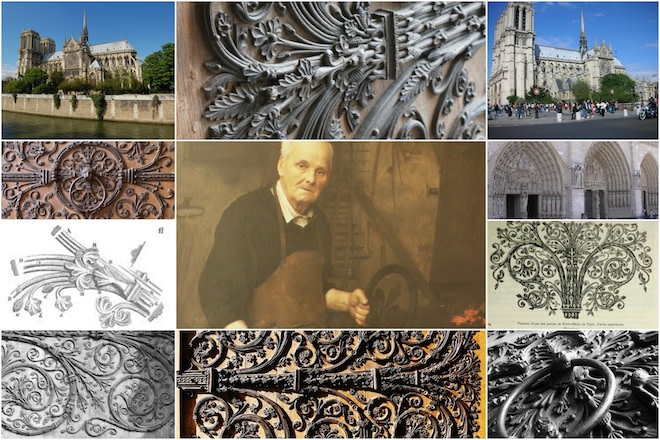
The blacksmith, who forged them, was called “Bicornett” (Two-Horned) by his contemporaries because the popular belief was that such things could only be created with the help of the Devil himself. Legend has it that Master Bicornett could finish the work on the side portals, but the one facing the altar in the central nave was never to be set up due to the Devil’s evil intentions.
The truth is that the portal disappeared during the French Revolution, and it was only replaced in the 1860’s thanks to the restoration works led by Viollet-le-Duc. They were fortunate enough to find an excellent blacksmith, Pierre Boulanger, who was not only able to recreate the hinges on par with the originals, but also improved the design with his precision and attention to detail.
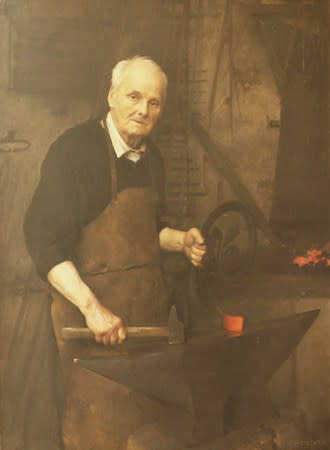
Since that time this knowledge has seemed to be lost forever and a great number of craftsmen have tried to get around the problem without success.
These hinges form a very complex pattern by plastically combining nature-inspired decorative elements such as leaves, flowers and animal heads. In addition, there are cover plates and bands applied to the crossing branches that need to be placed properly, which even skillful craftsmen find completely impossible. What seemed impossible to solve was how all these intricate pieces – which were all different in size and weight – could be set together with forge welding in such a way that they would not be damaged but would make one solid structure.
In forge welding the pieces of metal are heated to almost their melting point, then fitted and hammered together. This takes great practice and attention even in simpler structures. However, we’d have thought it to be impossible in a piece as complex and intricate as the hinges of the portal of the Notre-Dame. In today’s world, where forge welding has almost entirely been rendered obsolete by modern welding technology, it seemed impossible to crack the mystery of how the hinges of the Notre Dame were made. But there is someone who achieved the impossible.
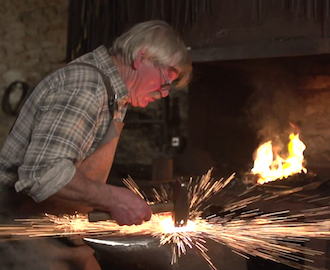
Walfrid Huber, Austrian blacksmith and artist is an avid researcher of the style and technical history of the blacksmith tradition. As many other blacksmiths, he also faced the same agonizing question: how were the hinges of the Notre Dame made? However, after lots of brainstorming, countless hours of trial and error and a lucky visit to a museum it all paid off: he was able to solve the riddle!
At the Musée Cluny he found a piece, which was very similar in structure and construction to the hinges of the Notre Dame. When he held it in his hands and examined it from all sides he was finally able to see all the layers. With this knowledge he has been able to devise the sequence of steps that are necessary to create this masterpiece.
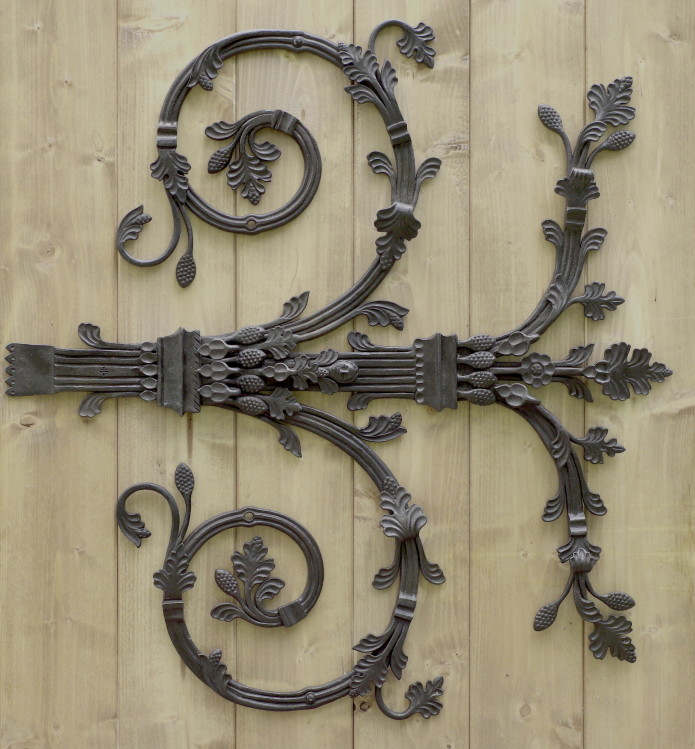
The Devil’s Blacksmith documentary Indiegogo campaign (closed)
How to be The Devil’s Blacksmith documentary Indiegogo campaign (closed)
Article in german at dorfschmied.wordpress.com
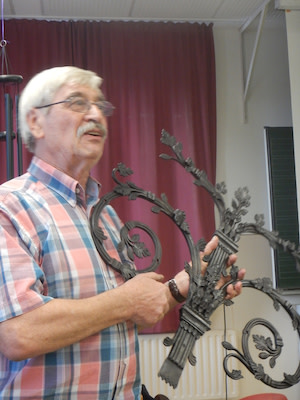
Zoltan Takats on the Forge welding video tutorial
(transcript from the video teaser):
I am Zoltán Takáts, Head of Hungarian Blacksmith Guild. We’ve spent several years preserving, conserving and documenting the heritage of our craft. We’ve recently shot a documentary of the wrought iron band hinges of the Notre Dame Cathedral, Paris. When we nearly finished this blacksmith video project we just realized that not only we should make a documentary about it, but also we should make a video tutorial for our colleagues. So that is our main focus right now. This educational video will cover the whole process of our work, starting from building a fire, handling the fire, choosing the right material, setting the air level, etc. We try to cover every tiny detail, and, of course, follow the process of making this really interesting wrought iron band hinge step by step. Forge welding is definitely the main focus of this video. We also cover the different kinds of forge welding techniques. After that we reach the part where we can show the process of forging this very interesting and complex hinge.
Our previous documentary about the wrought iron band hinges of Notre Dame Cathedral, The Devil’s Blacksmith, was shot with the participation of our very good friend and colleague, Master Huber, and was supported by the Austrian Federal Monuments Office, Mauerbach. We’ve also started a crowdfunding campaign and were really happy that we were backed by many of our colleagues around the world. So following this successful project we decided to start a support campaign for this project, too. This campaign lasts for 60 days. Please follow us at our social media profiles for more information. Thank you for your precious time! Wish us good luck!
Special contributors to The Devil’s Blacksmith and How to be The Devil’s Blacksmith video projects
We truly appreciate the amazing support of several blacksmith associations, blacksmith colleagues and non-blacksmith friends worldwide on our previous blacksmith video projects. We’re truly honoured.
Austrian Locksmiths and Blacksmiths’ Guild
Education Center of Austrian Federal Office for Monuments Care, Mauerbach
Black Bear Forge – John Switzer

ABANA (Artist Blacksmith Association of North America)


Artistic Anvil – Travis C. Fleming

Artist Blacksmith’s Association of Finland
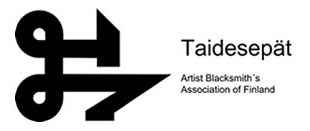
Jim and Nicholas Archambault – Elite Custom Ironworks

Eric O’Neill – Killuragh Kraftworks

Russel Jones – Santa Cruz Gates
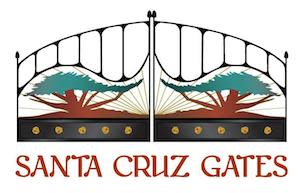
Special Contributor’s Film Credit
The Devil’s Blacksmith documentary
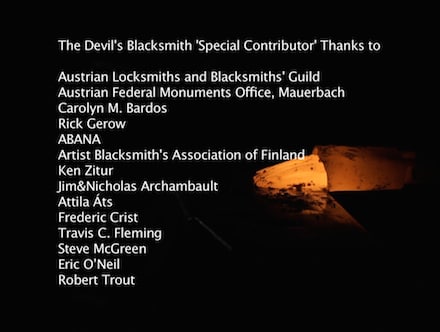
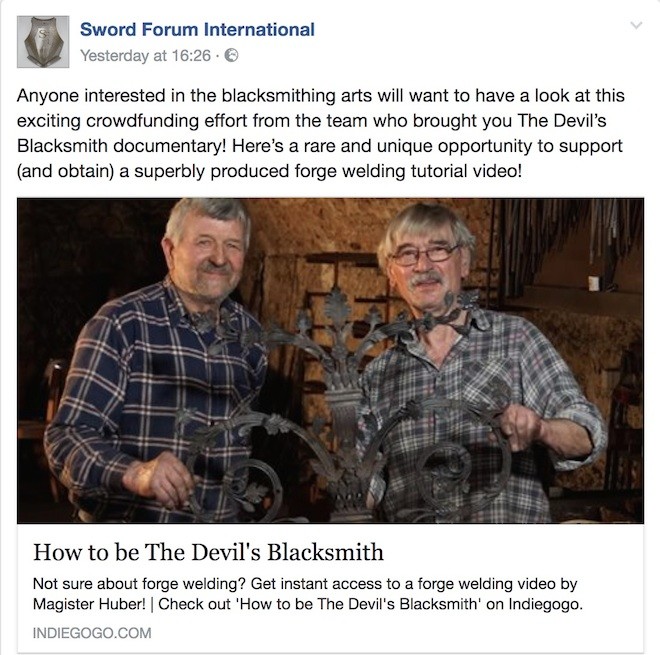
The Devil’s Blacksmith Support items
Feel free to choose one of these for contributing to our Blacksmithing 101 series
-
 DVD – The Devil’s Blacksmith documentary25 $
DVD – The Devil’s Blacksmith documentary25 $ -
 Devil’s Blacksmith – Hoodie40 $
Devil’s Blacksmith – Hoodie40 $ -
Product on sale
 A little piece by Magister Huber249 $
A little piece by Magister Huber249 $ -
Product on sale
 A little piece by Magister Huber349 $
A little piece by Magister Huber349 $ -
Product on sale
 A little piece by Magister Huber299 $
A little piece by Magister Huber299 $ -
 Double DVD – The Devil’s Blacksmith + How to be The Devil’s Blacksmith50 $
Double DVD – The Devil’s Blacksmith + How to be The Devil’s Blacksmith50 $ -
 DVD – How to be The Devil’s Blacksmith25 $
DVD – How to be The Devil’s Blacksmith25 $ -
 Video download – How to be The Devil’s Blacksmith19 $
Video download – How to be The Devil’s Blacksmith19 $ -
 Devil’s Blacksmith – Support T-Shirt24 $ – 26 $
Devil’s Blacksmith – Support T-Shirt24 $ – 26 $ -
Product on sale
 Video Download – The Devil’s Blacksmith documentary19 $
Video Download – The Devil’s Blacksmith documentary19 $ -
 Devil’s Blacksmith – Support Bag23 $
Devil’s Blacksmith – Support Bag23 $ -
 Devil’s Blacksmith – Support Hat35 $
Devil’s Blacksmith – Support Hat35 $
Risks & Challenges
Anyone can contribute to the project in the following months, but you can also help us reach our goal after that. We try to shoot continuously as our fundings are coming in. Our first three episodes were supported by a Hungarian Foundation.
Our budget per videos would be cca. $1500-2500 depending on the length of the shootings for an episode.
Do not forget, sharing our project is also a great way of contribution.
Other Ways You Can Help
Some people just can’t contribute, but that doesn’t mean they can’t help.
Feel free to use the Facebook, Instagram, etc. share tools! You can also
- forward this campaign to your friends and colleagues and community.
The more people get to know our goal the more chance we get for finishing our video projects successfully.
Thank you for your precious time.
Together we can make this happen!

























